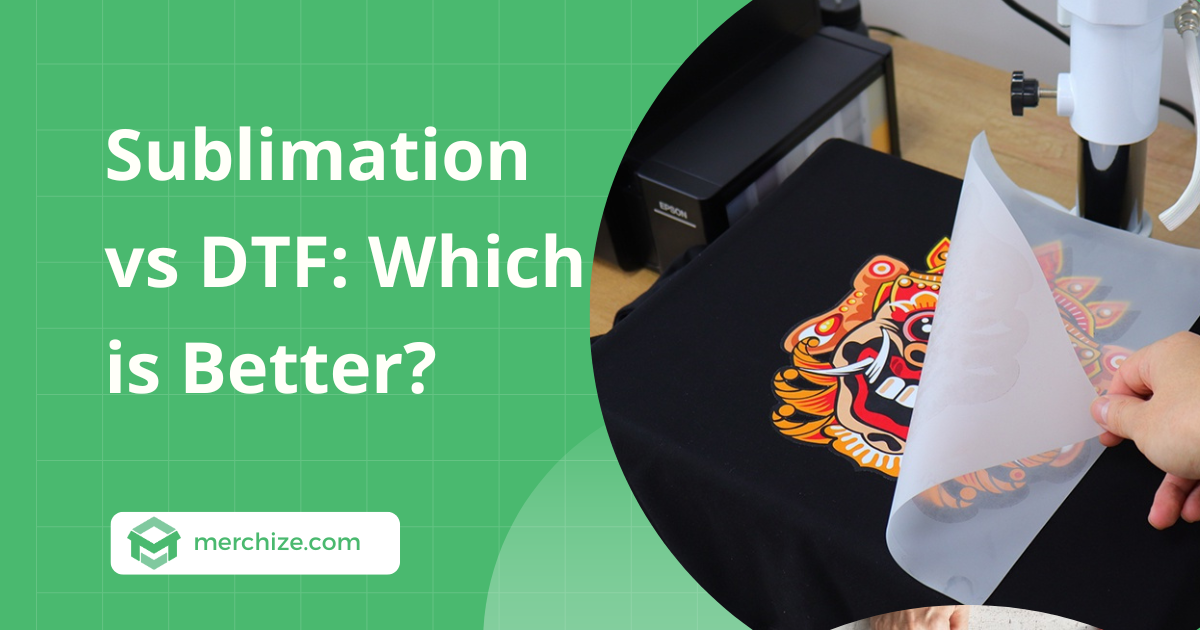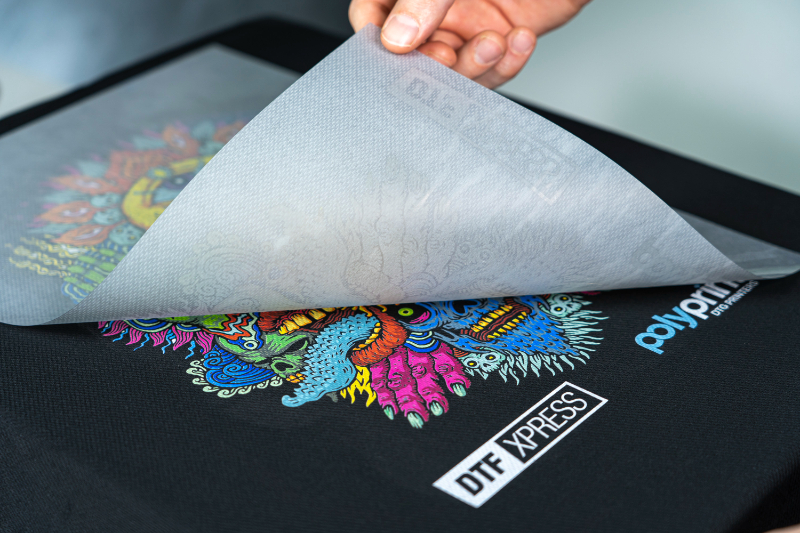Contents
If you are looking for a printing technique that can yield impressive results, DTF and Sublimation will be the top two contenders. Both of these printing methods can deliver high-quality prints with great detail and vibrant colors. Moreover, both are also categorized under the heat transfer printing section. However, they feature some distinctive differences that make each suitable for different purposes.
To better understand the differences and how each printing method should be employed, Merchize will guide you through a detailed comparison between these two printing technologies.
What Is DTF Printing and How Does It Work?
Direct-to-film printing is one of the latest inventions in the printing industry. The introduction of DTF has helped to remove many limitations in printing. For example, DTF can print on various materials, from synthetic to natural fiber fabrics. It can also handle complex designs with intricate details and vibrant colors.
Technically, DTF could be considered a form of heat transfer printing. It doesn’t require direct printing onto the materials. Instead, the design will be printed onto a PET film and then transferred to the substrate using a heat press machine.
DTF’s impressive ability results from smaller technical improvements here and there.
- Pigment-based inks: DTF utilizes specialized pigment-based inks that offer high color vibrancy and durability. These inks are designed to adhere well to the film and subsequently to the fabric, ensuring long-lasting prints with rich colors.
- DTF printers: DTF uses dedicated printers that can achieve high-resolution prints with fine details, which is often challenging for other transfer methods.
- PET Film: DTF uses high-quality PET (polyethylene terephthalate) film. This type of transfer film is heat-resistant, and smooth on the surface, which ensures consistent printing without wrapping or distortion as well as excellent ink deposition. Especially, PET film is compatible with a wide range of fabrics, including cotton, polyester, blends, and synthetic materials.
- Adhesive Powder: DTF employs a heat-activated adhesive powder as a bonding agent. This powder is applied to printed film. During the heat press process, it melts under high temperatures, creating a strong bond between the ink and the fabric. This results in prints that are more durable and resistant to washing and stretching.
DTF Printing process:
Now, let’s dig into the detailed process of how DTF prints are made:
- Create a design using graphic design software.
- Print the design onto a PET film using a DTF printer equipped with DTF inks.
- Apply a hot melt powder to the printed film while the ink is still wet.
- Cure the film using a heat press or an oven to bond the powder to the ink.
- Place the cured film onto the fabric and use a heat press to transfer the design. The heat activates the adhesive, bonding the design to the fabric.
- After cooling, peel the film away, leaving the design on the fabric.
Advantages of DTF:
- Versatility: DTF works on a wide variety of fabrics, including cotton, polyester, blends, silk, nylon, and more. Additionally, it’s also suitable for printing on non-textile materials like leather, wood, and other surfaces.
- High-quality prints: DTF can produce vibrant, high-resolution prints with excellent color fidelity, be it gradient or photographic designs. The use of white ink allows for bright and opaque prints on dark fabrics.
- Durability: DTF prints are durable and can withstand repeated washing without significant fading, cracking, or peeling. The adhesive powder used in the process ensures strong adhesion to the fabric.
Disadvantages of DTF:
- Slight texture: DTF prints can have a slightly raised print texture due to the additional adhesive layer. While the print is generally soft and flexible, it may not be as smooth as sublimation prints or DTG prints on cotton.
- High equipment costs: While the setup costs are lower than screen printing, DTF still requires investment in specialized printers, heat presses, and adhesive powder application equipment.
What Is Sublimation Printing and How Does It Work?
Similar to other heat transfer printing techniques, sublimation also uses the same mechanism to create print: Print is transferred from transfer paper onto the substrate and bonds with the material under high temperature and pressure.
While the process is the same, sublimation holds a secret that allows it to achieve some impressive printing outcomes. It’s the special dye-based inks that can convert from a solid state directly to a gas without passing through a liquid state, which is also why it is called sublimation. This ink is the special factor that forges the magic of sublimation: It allows the ink to penetrate the substance’s fiber and become a part of the material.
Sublimation Printing Process:
To better understand how sublimation works, let’s go through all the steps of the sublimation process:
- Create a design using graphic design software.
- Print the design onto sublimation transfer paper using a sublimation printer and sublimation inks.
- Place the printed transfer paper onto the polyester substrate and use a heat press. The heat causes the ink to sublimate and bond with the polyester fibers.
- Remove the transfer paper, revealing the design permanently embedded into the substrate.
Advantages of Sublimation
- Vibrant, bold, high-quality prints: Sublimation printing can produce highly detailed images with bright, vibrant colors due to the high quality of dye-based inks used in the process. Custom-designed photo gifts, like mugs or phone cases, showcase intricate designs and vivid hues that capture the original artwork or photograph perfectly.
- Durable and seamless prints: With sublimation printing, the ink will penetrate and integrate with the material, leaving no trait of print layers. Instead, prints and fabrics become just as one.
- All-over print design: Sublimation printing is ideal for all-over prints, as the fabric retains its original texture and flexibility, even when the entire surface is printed.
- Suitable for a wide product range: Sublimation printing is suitable for a wide range of products, including apparel, home decor, and promotional items. You can use sublimation printing to print on textiles as well as other materials like metal, plastics, ceramic, and more.
Disadvantages of Sublimation
- Only compatible with light-colored polyester fabric: Sublimation printing is only effective on light-colored, polyester-based fabrics, as the dye needs to bond with synthetic fibers. Attempting to sublimate on dark cotton t-shirts results in poor color reproduction and a design that quickly fades or washes away.
- Requires expensive investment: Setting up a sublimation printing operation requires significant investment in specialized equipment, including sublimation printers and heat presses.
Similarities between DTF vs Sublimation
Both DTF and sublimation rely on the power of heat and pressure to transfer printed designs onto the substrate. That’s why, whether you are applying sublimation or DTF, you always need a heat press machine at hand.
Compared to other printing methods, DTF and sublimation share one advantage: Both can deliver great-quality printing with a high level of precision. Both printing methods can bring the vibrancy and complexity of a design to life, creating captivating and impressive prints on fabrics.
Another plus point for these two printing techniques is that both can portray a full range of colors with precision. It is perfect for showcasing photographic designs and special graphic effects like gradients. This opens a whole world of possibilities for printing.
DTF and Sublimation printing are also two popular printing choices for making customized and personalized orders. Since neither requires a complicated setup, it is easy to switch designs. You can also these two options are also quite popular among print on demand businesses, especially for sublimation printing.
Differences between DTF vs Sublimation
Materials
- DTF: Think of DTF as the ultimate team player—it works on almost anything! Cotton tees? Check. Polyester hoodies? Yes. A wild fabric blend? No problem. It’s your go-to for versatility.
- Sublimation: This one’s a bit more selective. It only works with polyester or high-polyester blends. Want to slap a design on a pure cotton shirt? Sublimation isn’t built for that.
On natural fiber fabrics, the sublimation print won’t be able to penetrate into the fiber, causing it to fall out or peel off easily. But for polyester and other synthetic fabrics, it works like a charm.
Why? DTF’s flexibility comes from its adhesive approach, while sublimation’s limitation is tied to the chemistry of how its ink interacts with fabric fibers.
Quick Tip: Pick DTF for cotton or blends. Go sublimation for polyester or other synthetic fabrics.
Durability
- DTF: DTF prints are built tough. Toss them in the wash over and over—they won’t fade or crack (if done right). The trick? The print is essentially glued onto the fabric with that adhesive layer, so it can handle multiple washes without fading or cracking. However, if the adhesive quality is low or the application isn’t spot-on, you might notice peeling or wear over time. It’s durable, but the execution matters.
- Sublimation: Imagine the dye sinking right into the fabric like a permanent tattoo. No peeling, no cracking—just a design that lasts as long as your item does. The ink doesn’t just sit on the fabric—it becomes part of the fibers. Wash it, wear it, repeat—it’s not going anywhere.
Why? DTF’s durability relies on the adhesive bond, which is strong but can fail if not done right. Sublimation’s edge comes from infusing the ink into the fabric, making it virtually indestructible on the right material.
Quick Tip: Both are champs, but sublimation might edge out slightly since it’s fused into the material.
Texture and hand feel
- DTF: With DTF, you’ll notice a slight texture where the design is. That adhesive layer adds a thin, raised feel—some compare it to a subtle plastic coating. It’s not heavy or stiff, but it’s there, especially on big designs. The fabric still feels soft overall, just with a little extra where the print sits.
- Sublimation: Sublimation is the champion of softness. Since the ink sinks into the polyester fibers, there’s no extra layer on top. The fabric feels exactly like it did before printing—smooth, natural, and super soft. You won’t even know there’s a design by touch alone.
Why? DTF’s adhesive and film leave a detectable layer, while sublimation’s gas-to-fiber process keeps the fabric unchanged.
Quick Tip: Sublimation’s your pick for a silky-smooth feel. DTF’s cool if a little texture doesn’t bug you.
All-over print compatibility
- DTF: DTF can do all-over prints, but it’s not the easiest or most practical choice. You’d need a large film to cover the entire garment and a massive heat press to transfer it evenly. Most setups aren’t built for that scale, so it’s usually limited to smaller designs or requires extra effort and cost for full coverage.
- Sublimation: Sublimation is built for all-over prints. You print the design on a big sheet of paper, press it onto a flat piece of polyester fabric (before it’s sewn into a garment), and voilà—edge-to-edge coverage, even over seams. It’s seamless and efficient, making it ideal for bold, full-shirt designs.
Order Size
- DTF: DTF is super flexible for any order size. You print each design onto its own film, apply adhesive, and press it—no screens or big setups required. Whether it’s one custom shirt or 100 pieces, the process stays the same, making it great for small runs or bulk orders alike.
- Sublimation: Sublimation is just as adaptable. You print each design on paper and press it onto the fabric individually. Like DTF, there’s no minimum order since there’s no costly prep work. It scales effortlessly from one-offs to large batches.
Both methods skip the setup hassles of traditional printing (like screen printing), so producers can handle any quantity without breaking a sweat. The difference isn’t in flexibility but in the steps involved, which we’ll cover next.
Takeaway: Small runs? DTF. Big runs? Sublimation.
Production Time
- DTF: DTF takes a bit longer per piece. The process involves printing the design on film, dusting it with adhesive powder, curing the adhesive, and then heat-pressing it onto the fabric. Each step adds time, especially if you’re doing it by hand. It’s not slow, but it’s not lightning-fast either.
- Sublimation: Sublimation is quicker and simpler. You print the design on paper, then heat-press it onto the fabric. That’s it—two steps. The lack of extra prep like adhesive application makes it faster, especially for straightforward designs.
Reasoning: DTF’s multi-step process naturally takes more time than sublimation’s streamlined approach. For producers racing against deadlines, sublimation’s speed could be a game-changer.
Sustainability
- DTF: DTF isn’t the greenest option. It uses PET films (plastic-based) that are single-use and adhesive powders that may not break down easily. Waste adds up, and the materials aren’t super eco-friendly, making it a bit of a sustainability challenge.
- Sublimation: Sublimation isn’t perfect either, but it has potential. The paper can sometimes be recycled, and the dye process doesn’t involve plastic films. However, it relies on polyester, a synthetic fabric that’s not biodegradable. Using recycled polyester or paper could tip it toward being greener.
Reasoning: DTF’s reliance on disposable films and adhesives weighs it down environmentally, while sublimation’s paper-based method offers a slight edge if paired with sustainable practices. Producers focused on eco-friendliness will need to weigh trade-offs with both.
Cost Breakdown
| DTF | Sublimation | |
| Equipment | Printer: A basic desktop DTF printer costs $2,000 to $3,000 (e.g., entry-level models), while professional setups can exceed $5,000. Let’s use $2,500 for a small business.
Heat Press: Same as sublimation, $400. Curing Oven: Required for curing adhesive powder, costing $500 to $1,000—let’s use $600. |
Printer: A Sawgrass SG500 (a popular desktop model) costs $550. For larger formats, an Epson F570 is around $3,000.
Heat Press: A 15×15-inch heat press ranges from $300 to $500—let’s use $400 as an average. |
| Materials |
|
|
| Labor | Printing time takes less than 5 minutes per print. | It takes longer to print the whole fabric, not to mention the time for cutting and sewing the fabric into the final products, which increases the labor cost for sublimation products.
The labor cost also takes up a huge part of the sublimated product’s total cost. |
Which Printing Method Should You Choose in 2025?
Both sublimation and DTF are suitable for print on demand businesses as they can allow flexibility for customization and personalization with no limitation in terms of minimum quantity. For example, at Merchize, we currently apply sublimation printing on a wide variety of products, from apparel to other decoration products.
However, in some cases, one printing method will be more suitable than the other.
When to choose DTF?
DTF is a great choice for small and medium-sized businesses. It has the versatility that allows you to experience different types of materials and products, allowing you to venture into many spaces in the market. Plus, the initial investment cost is manageable and suitable for small to medium-sized businesses. The running costs for this printing method are also inexpensive, so you won’t have to put out a significant investment.
When to choose Sublimation?
Sublimation runs on a larger scale. It takes up a bigger space for printing machines. The investment is also much higher. All of which makes it only suitable for established businesses, and not for smaller, newer ones.
In addition, sublimation works very well on synthetic fibers like polyesters and nylons, which are commonly used in sportswear. It is a no-brainer to choose sublimation printing for sports apparel.
Both DTF and sublimation printing offer unique advantages, making them invaluable tools for different printing needs. Whether you’re just starting or looking to expand your printing capabilities, understanding these methods will help you make the best choice for your business. Don’t be afraid to explore both techniques and find the one that fits your needs perfectly. With the right approach, you can create stunning, high-quality prints that will impress your customers and set your business apart.
You might want to read:
DTG vs DTF – Find The Best Printing Method for Your Business
Sublimation vs Screen Printing: 8 Key Differences
What is Direct to Film Printing?
What Are the Best Sweatshirts for Sublimation?
FAQs
1. Which is better for POD: DTF or sublimation?
It depends on your product type. DTF works on more materials (cotton, blends, dark fabrics), while sublimation offers vivid, durable prints on polyester.
2. Can I use sublimation on cotton?
No. Sublimation only bonds with polyester or polymer-coated surfaces. It doesn’t work on cotton garments.
3. Is DTF printing durable?
Yes. When applied correctly with quality film and powder, DTF prints are highly durable and resistant to washing.
4. Which is more beginner-friendly: DTF or sublimation?
Sublimation is easier for small setups, but DTF offers more flexibility in product range if you have the right equipment or fulfillment partner.






